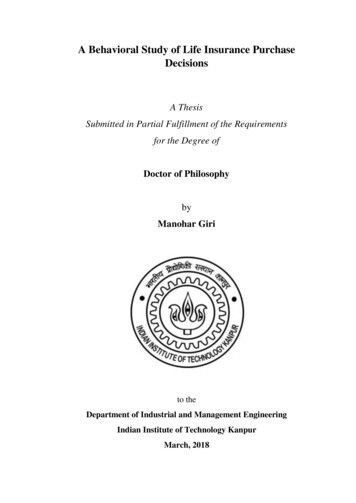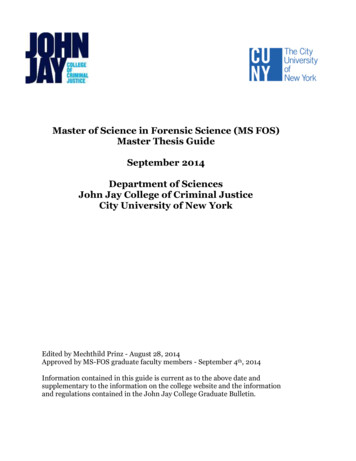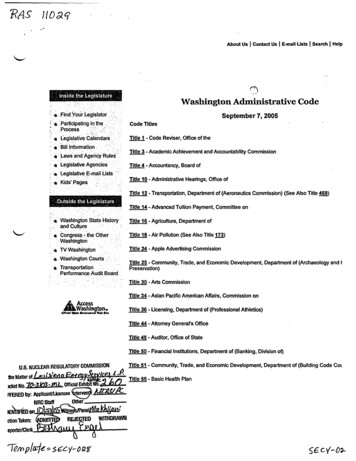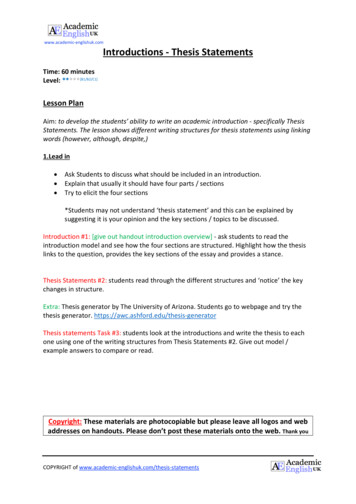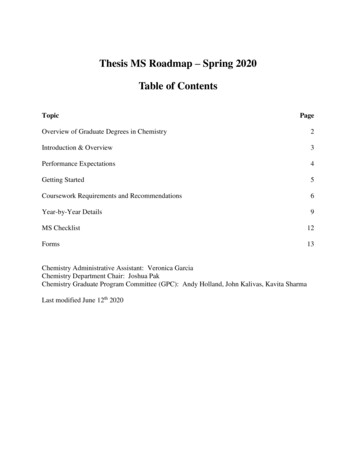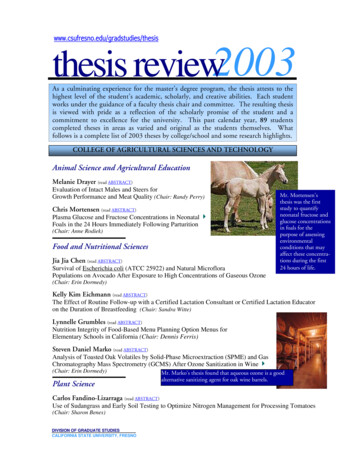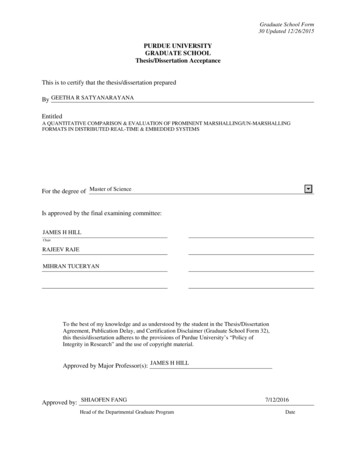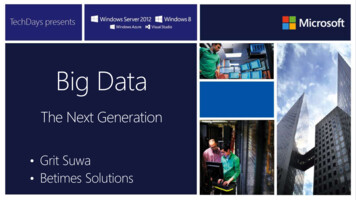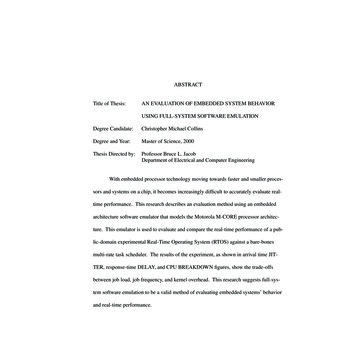
Transcription
ABSTRACTTitle of Thesis:AN EVALUATION OF EMBEDDED SYSTEM BEHAVIORUSING FULL-SYSTEM SOFTWARE EMULATIONDegree Candidate:Christopher Michael CollinsDegree and Year:Master of Science, 2000Thesis Directed by:Professor Bruce L. JacobDepartment of Electrical and Computer EngineeringWith embedded processor technology moving towards faster and smaller processors and systems on a chip, it becomes increasingly difficult to accurately evaluate realtime performance. This research describes an evaluation method using an embeddedarchitecture software emulator that models the Motorola M-CORE processor architecture. This emulator is used to evaluate and compare the real-time performance of a public-domain experimental Real-Time Operating System (RTOS) against a bare-bonesmulti-rate task scheduler. The results of the experiment, as shown in arrival time JITTER, response-time DELAY, and CPU BREAKDOWN figures, show the trade-offsbetween job load, job frequency, and kernel overhead. This research suggests full-system software emulation to be a valid method of evaluating embedded systems’ behaviorand real-time performance.
AN EVALUATION OF EMBEDDED SYSTEM BEHAVIORUSING FULL-SYSTEM SOFTWARE EMULATIONbyChristopher Michael CollinsThesis submitted to the Faculty of the Graduate School of theUniversity of Maryland, College Park in partial fulfillmentof the requirements for the degree ofMaster of Science2000Advisory Committee:Professor Bruce L. Jacob, ChairProfessor Shuvra S. BhattacharyyaProfessor Donald Yeung
ACKNOWLEDGEMENTSI would like to thank Eric Fiterman and Tiebing Zhang for their assistance in theresearch that led up to this report. They both aided in the creation of the emulator andspent many hours debugging and running simulations.I would like to thank Moussa Ba, Julian Requejo, Sujaya Srinivasan, and Dr.David B. Stewart in the SERTS lab for their assistance with their Echidna operating system and the Motorola M-CORE evaluation board.I would like to thank Dr. Bruce L. Jacob for giving me the opportunity to workon this project and for many hours of assistance with the research itself in addition to thedevelopment of this report.On a personal note, I would like to thank my parents, John and Joan M. Collins,for their support and understanding throughout this project.Finally, I would like to thank Danesha R. Fitzgerald, for her support, for keepingme sane, and most importantly, for believing in me.ii
TABLE OF CONTENTSList of TablesviList of FiguresviiList of AbbreviationsviiiChapter 1:Introduction1.1: Goal and Motivation1.2: Results1.3: Overview of Report1145Chapter 2:Background2.1: Embedded Systems2.1.1: Embedded Systems versus General Purpose Systems2.1.2: Design Issues2.1.3: Development Tools2.1.4: Embedded System Trends2.1.4.1: Application Specific Integrated Circuits2.1.4.2: Systems On A Chip2.1.5: The Emulator’s Benefit to Embedded System Design2.2: Hardware/Software Codesign2.2.1: Hardware/Software Codesign: The Concept2.2.2: Hardware/Software Codesign: The Methodology2.2.3: Model Based Codesign2.2.4: The Emulator’s Benefit toHardware/Software Codesign2.3: Real-Time Operating Systems2.3.1: Real-Time Operating Systems: The Requirments2.3.2: User Tasks and Threads2.3.3: The Kernel2.3.4: Synchronization and Communication2.3.5: The Emulator’s Benefit toReal-Time Operating Systems2.4: Evaluation of Real-Time Systems2.4.1: Methods of Evaluation2.4.2: Metrics of Characterization2.4.3: Current Studies2.4.4: The Emulator’s Benefit to the Evalationof Real-Time Systems2.5: SimOS2.5.1: The SimOS Approach2.5.2: Studies Performed with 222222324
2.5.3: SimOS versus Our Emulator25Chapter 3:The Emulator3.1: M-CORE Architecture3.2: Emulator Parts3.2.1: ELF Input3.2.2: Main Memory and Registers3.2.3: Write Back Stage3.2.4: Execution Stage3.2.5: Instruction Decode Stage3.2.6: Instruction Fetch Stage3.2.7: Post Stage Maintenance3.2.7.1: The Timer3.2.7.2: Interrupts3.2.7.3: Exceptions3.2.8: Output3.3: Validating the Emulator262632323335353637373738394041Chapter 4:Real-Time Performance Evaluation4.1: Echidna RTOS4.2: NOS4.3: Benchmarks4.3.1: Periodic Inter-Process Communication4.3.2: Up Sampling4.3.3: Down Sampling4.3.4: Finite Impulse Response Filter4.4: Background Load4.4.1: Control Loop4.4.2: Aperiodic Inter-Process Communication4.5: The Experiment454546484949494950505051Chapter 5:Results and Analysis5.1: JITTER5.1.1: Periodic Inter-Process Communication5.1.2: Up Sampling5.1.3: Down Sampling5.1.4: Finite Impulse Response Filter5.1.5: JITTER Summary5.2: DELAY5.2.1: Periodic Inter-Process Communication5.2.2: Finite Impulse Response Filter5.2.3: DELAY Summary5.3: CPU Breakdown5.3.1: Periodic Inter-Process Communication5.3.2: Finite Impulse Response Filter5.3.3: CPU Breakdown Summary535354626872797980838686878991iv
5.4: Analysis Summary91Chapter 6:Conclusions93Chapter 7:Future Work96Appendix A: M-CORE Instruction SetReferences98102v
LIST OF TABLES1.Test Applications43A-1.M-CORE instructions98vi
LIST OF FIGURES1.The SimOS Environment.242.The Emulation Environment.273.Instruction Format.284.User Program Model and Supervisor Additional Resources.315.Format of an ELF file.336.The M-CORE pipeline.357.Output Example.428.NOS Main Loop.489.JITTER probability density graphs for P-IPC on Echidna.5510.JITTER probability density graphs for P-IPC on NOS.6011.JITTER probability density graphs for UP on Echidna.6312.JITTER probability density graphs for UP on NOS.6613.JITTER probability density graphs for DOWN on Echidna.6914.JITTER probability density graphs for DOWN on NOS.7115.JITTER probability density graphs for FIR on Echidna.7416.JITTER probability density graphs for FIR on NOS.7717.Delay probability density graphs for P-IPC.8118.Delay probability density graphs for FIR.8419.CPU-BREAKDOWN graphs for P-IPC.8820.CPU-BREAKDOWN graphs for FIR.90vii
LIST OF ABBREVIATIONSASICApplication Specific Integrated CircuitAP-IPCAperiodic Inter-Process CommunicationCLControl LoopCPUCentral Processing UnitELFExecutable-Linking FormatEPCException Program CounterEPSRException Program Status RegisterEXExecution StageEXWBThe boundary between the Execution andWrite Back stagesFPCFast Interrupt Program CounterFPSRFast Interrupt Program Status RegisterIDInstruction Decode StageIDEXThe boundary between the Instruction Decodeand Execution StagesICIntegrated CircuitIFInstruction Fetch StageIFIDThe boundary between the Instruction Fetch andInstruction Decode stagesIPCInter-Process CommunicationIRAMIntelligent RAMFIRMAINFinite Impulse ResponseThe boundary before the Instruction Fetch stage,the instruction about to enter the pipeviii
NOSNon-Operating SystemPCProgram CounterPSRProgram Status RegisterRAMRandom Access MemoryROMRead-Only MemoryRTOSReal-Time Operating SystemSOCSystem on a ChipVBRVector Base RegisterWBWrite Back StageWBEndThe boundary after the WB Stage, whenthe instruction leaves the pipeix
Chapter 1: IntroductionWith embedded processor technology moving towards faster and smaller processors and systems on a chip, it becomes increasingly difficult to accurately evaluate realtime performance. Probing a piece of silicon, or accurately measuring values approaching less than one nanosecond becomes more expensive and more difficult, if not impossible. It becomes necessary to find additional methods to evaluate and debug embeddedsystems.1.1: Goal and MotivationThe goal of this research is to provide an additional method for evaluating anddebugging embedded systems. This research presents a method of using full-systememulation to evaluate the real-time performance of an embedded system. An embeddedarchitecture emulator was created, using the C programming language, that emulates theMotorola M-CORE embedded processor down to the register level and is accurate towithin 100 cycles per million as compared to actual hardware. This work touches onseveral different aspects of embedded systems design, such as the testing and debuggingof increasingly integrated systems, hardware/software codesign methodologies, and theevaluation of real-time systems.One of the motivators of this research is that it is becoming increasingly difficultto evaluate system behavior at the hardware level. Apart from the unpleasantries of1
waiting for actual fabrication of the hardware, or the expense of such a task, it is sometimes difficult to obtain information from the actual hardware. Five, ten years ago it waseasy enough to hook up a probe to the bus connecting the processor to the main memoryor the connections between the processors and other pieces of the hardware. However,with the advent of systems on a chip and application-specific integrated circuits, it is nolonger possible to obtain those signals, for they never leave the silicon [32, 45]. Theonly way to debug these systems is to either probe the silicon itself, or to add additionallogic to the chip so that it brings the signal off the chip, and even that option is limited bythe number of physical pins that can be put on a chip and spared for simple debug andevaluation purposes. Also, with the speeds that some of today’s embedded processorsare running, it becomes difficult to find a logic analyzer that can keep up with the processors, not to mention costing tens to hundreds of thousands of dollars [20, 29]. If therewere another method to evaluate these systems early on, both valuable time and moneycould be saved.One of the methodologies gaining wide acceptance in both the embedded worldand the general purpose world is that of hardware/software codesign [24]. As opposedto the traditional methods of developing the hardware and software for a system separately, the hardware/software codesign methodology recognizes the benefits inherent inthe designing of the two together, at the same time. The hardware being designed withthe software needs in mind as well as the designing of the software with hardware limitations and issues in mind benefit the design both in performance and time to market,given that if hardware and software designers communicate during the design process,there is less chance of problems happening due to ignorance [9]. This research offers a2
method for the software engineer to test his software on a C emulator, something that hewill understand, as opposed to handing the software off to a technician to go run it on theactual hardware, or for him to try to understand how to operate a VHDL model.Real-Time Operating Systems are commonly used in the development, productizing, and deployment of embedded systems. Unlike the world of general purpose computing, embedded systems are usually developed for a limited number of tasks. Anyfacilities that these tasks might need are often built directly into the code and the feelingis often that real-time operating system would just add unnecessary overhead [13]; inmany cases, any RTOS functionality needed is provided by a homegrown design. However, these “roll-your own” [13] pseudo operating systems that are created on the fly arenot very portable and often times include additional work that could easily be accomplished by using one of today’s many commercial RTOSs. What is needed is a methodto test both commercially available Real-Time Operating Systems and in-house creations on the target architecture to verify which would give the best behavior.Many of the projects in the area of real-time systems concern themselves withthe development of scheduling algorithms and the demonstration that those algorithmswork [1,2,53,54]. However, as others have observed [28], “there currently exists a widegap between real-time scheduling theory and the reality of RTOS implementation.” Themajority of the work in this field is done through theoretical analysis testing the scheduler code at the block level, or running the raw scheduler code by itself. Very little ofthat analysis follows those scheduling algorithms all the way to the RTOS implementation, where other mechanisms like inter-process communication and semaphores interact in subtle ways to make the behavior of the algorithms less easily understood and3
therefore less predictable. The analysis of these scheduling algorithms should beaccompanied with experimental evaluation of RTOSs on the actual hardware. Unfortunately, this sometimes presents a problem when the hardware is not available, or thereare questions of money or time. However, if it was possible to run tests on an emulationof that hardware, that would save both time and money and allow this analysis to becomplete.The research effort going on currently that most resembles this work is theSimOS project going on at Stanford [44]. Like the emulator described in this research,SimOS is an execution driven simulator that is accurate enough to run a full operatingsystem on top of it. The primary difference between the emulator developed for thisresearch and SimOS is the target application domain. SimOS is focused on studyinghigh performance machines, while the emulator created for this work is interested inevaluating the real-time performance of low power embedded processors.1.2: ResultsIn this research, an embedded system emulator was built in C. A study of twoReal-Time Operating Systems was run on that emulator. Echidna [10] is a publiclyavailable RTOS based on Chimera [48]. NOS is a fixed-priority, multi-rate executive[27] based on descriptions of bare-bones RTOS given by designers in the industry [13].This study provides information about both of the RTOSs that might lead to adecision among them as to which one to use. Predictably, as loads increased, the RTOSshit their job deadlines until system loads were reached and missed those deadlines afterwards. Also predictably, as the system became overloaded in NOS, lower priority taskswere completely ignored. It is seen that RTOS overheads are extremely high when com-4
pared to low overhead tasks. In some cases, the RTOS can account for more than 90%of the processor’s busy time. However, as the periodic task’s complexities and CPUrequirements grow, the proportion of the RTOS diminished significantly, to a pointwhere the RTOS accounts for only 20-50% of the processor’s busy time. Lastly, thisstudy has shown that this method of using a full-system software emulator can be usedas a valid method for the evaluation of embedded system behavior.1.3: Overview of ReportChapter 2, Background, describes the work that has been done in this field andareas that relate to this field of research. Chapter 3, The Emulator, gives a detaileddescription of the emulator, the steps that went into making it, and the methods used toverify it. Chapter 4, Real-Time Performance Evaluation, first describes the two differentReal-Time Operating Systems that were run on the M-CORE Emulator, Echidna andNOS, describes the four benchmarks that were run on each of the real-time operatingsystems, describes the two types of background load run on the real-time operating systems, and describes the experiment. Chapter 5, Results and Analysis, displays theresults from the experiment listed in Chapter 4, and analyzes the different results for theseveral benchmarks. Chapter 6, Conclusions, gives the conclusions drawn from the findings of this paper, and Chapter 7, Future Work, describes possible continuation of thiswork.5
Chapter 2: BackgroundThis chapter offers a brief background into the areas that are related to theresearch performed in the report as well as the areas that support the reasons for performing this research. The first section takes a look at embedded systems, the issues andtools involved in their design, current trends, and how they can benefit from thisresearch. The second section examines Hardware/Software Codesign, the methodologies that it has produced, and how those methodologies can benefit from this research.The third section gives an introduction to real-time operating systems and breaks downthe issues involved in their creation and use. Section four discusses the evaluation ofreal-time systems, the methods used to evaluate those systems, the metrics used to characterize them, and the current studies going on in the field. In the final section of thischapter, SimOS, a full-system simulation very much like the emulator created in thisresearch is described, and the studies that have been performed with it are listed, as wellas how it differs from the emulator created in this research.2.1:Embedded SystemsEmbedded systems has become a buzz word in the last five years, but embeddedsystems and processors have been around for much longer than that [46]. One onlyneeds to look around to see embedded systems everywhere: cell phones, alarm clocks,personal data assistants(PDAs), automobile subsystems such as ABS and cruise control,6
etc. This section takes a look at embedded systems, the issues and tools involved in theirdesign, current trends, and how they can benefit from the research performed for thisreport.2.1.1: Embedded Systems versus General Purpose SystemsAn embedded system is usually classified as a system that has a set of predefined, specific functions to be performed and in which the resources are constrained[46]. Take for example, a digital wrist watch. It is an embedded system, and it has several readily apparent functions: keeping the time, perhaps several stopwatch functions,and an alarm. It also has several resource constraints. The processor that is operatingthe watch cannot be very large, or else no one would wear it. The power consumptionmust be minimal; only a small battery can be contained in that watch, and that batteryshould last almost as long as the watch itself. And finally, it must accurately display thetime, consistently, for no one wants a watch that is inaccurate. Each embedded designsatisfies its own set of functions and constraints. According to [46], there are an estimated 50,000 new embedded designs a year.This is different from general purpose systems, such as the computer that sits ona desk in an office. The processor running that computer is termed a “general purpose”processor because it was designed to perform many different tasks well, as opposed toan embedded system, that has been built to perform a few specific tasks either very wellor within very strict parameters.2.1.2: Design IssuesAs mentioned above, embedded systems are defined by their functions and theirconstraints. These constraints are almost as varied as the number of embedded systems7
themselves, but a few of the more prevalent ones are response time accuracy, size, powerconsumption, and cost [46]. All of these present the embedded system designer withsome difficult decisions.Response time is a critical factor in many embedded systems. Whether it is aspecific time that an embedded system tasks needs to be run, like that of the alarm on analarm clock; or the time between tasks that is important, like the system that deliverspain medication to a burn victim; all of these are time-critical issues. The most difficulttask for an embedded system designer to do is to quantify these time deadlines, decidewhether these deadlines are firm, and recognize what the consequences are if these deadlines are not met.Size, as mentioned above, is also an important decision in many embedded systems. Many embedded systems designed today are bought and sold simply because theyare smaller than the last implementation of that product. Take for example, the cellularphone. Today’s cellular phones are half the size of the phones available two years ago,and those phones two years ago were smaller than the phones available before them. Soif the manufacturer does not take into account size when designing his cell phone, hewill most likely go out of business shortly after he produces a cell phone that is two tothree times the size of all of his competitor’s phones.Another design issue concerning today’s embedded system designers is that ofpower consumption. Continuing along the same line as the above mentioned size factor,many of these devices that are very small are handheld devices that are made to bemobile and thus must have a battery. Since the designer does not want the user to beforced to plug in or recharge the device every five minutes, the designer must make8
important choices in his design decisions and balance a feature’s merits against thepower that the feature will consume.A final consideration that embedded designers deal with is cost. Regardless ofany choice of the above issues made, an embedded product is not going to sell if its costis exorbitant. Most end users will sacrifice a small amount of performance, or a slightlyless amount of battery time, for an embedded product that is less costly than all of itscompetitors. So just as with all of the above considerations, the designer must considerthe cost of adding a particular modification to the design and whether or not the end userwill be willing to pay that additional cost for that additional feature.2.1.3: Development ToolsEmbedded development tools have traditionally lagged behind tools for thedevelopment of general systems [46]. Unlike general systems, the design space forembedded systems is extremely large, so it is difficult to contain all of the facilities tospecify, design, and test embedded systems.However, now that embedded systems have garnered more interest in theresearch community as well as there being an increased need for those embedded systems, embedded systems tools are now catching up with regular system design tools, andthey have become more readily available and diverse in their area of coverage [46].Tools that were not available 5 to 10 years ago are now available as part of commonEDA development suites. Also, tools are now available for the development of embedded system application software as well as the development of real-time operating systems.9
2.1.4: Embedded System TrendsWith the increase in interest and research of embedded systems have come aflood of new design trends. It is hard to envision that five years from now embeddedsystems will bear much resemblance to the systems today [46], other than their basicfunctionalities, and even those may be replaced in the future. Two of the trends currently hot in the embedded systems world that are discussed here are that of applicationspecific integrated circuits (ASICs) and systems on a chip (SOC).2.1.4.1:Application Specific Integrated CircuitsThe best way to define an application specific integrated circuit (ASIC) is to saying what it is not: an integrated circuit designed for multiple uses. Like the title suggests, this is a IC that has been designed for a specific application. Examples of ICs thatare not ASICs are standard computer parts such as RAM, ROM, multiprocessors, etc.Examples of ICs that are ASICs are a chip designed for a toy robot or a chip designed toexamine sun spots from a satellite [45].The reason for mentioning this is that since ASICs are developed for a specificpurpose, they are most likely constrained with both a tight budget and a short time tomarket. Any and all methods that might aid in the development of these chips would bewelcomed with open arms in the industry.2.1.4.2:System On A ChipSystem on a chip (SOC) is exactly what it sounds like. Hardware designers havetaken the normally separate pieces of a complete system; the CPU, memory controller,main memory, I/O control, and the various buses and interconnects, and placed many or10
all of them on a single piece of silicon. This has the added benefits of size reduction,power reduction, cost reduction, and time delay reduction.On of the more popular forms of SOC is that of Dave Patterson’s IntelligentRAM (IRAM) [20, 29]. IRAM is the combination of a processor on a chip with a largearea of DRAM instead of or in addition to cache. This concept has several advantages.Like all forms of SOC, it reduces the number of chips in a system, allowing the productto be smaller and less expensive. IRAM addresses the key bottlenecks in many systems:memory bandwidth and memory latency. Memory bandwidth on IRAM is four times aswide as that on traditional systems, and memory latency is considerably less than that oftraditional systems since the signals do not need to cross a pin barrier that can have amaximum number of pins.However, there are also several inherent difficulties with SOC and IRAM. One isthat there is only so much area on a chip, and this limits what you can put on it. It putsupper limits on the amount of main memory that you can have with a system, unless youstill want to rely on going off-chip occasionally for information. Another large problemis that the design team creating the system on a chip must contain all of the knowledge tocreate a processor, a main memory, a I/O controller, and optimize all of them together [3,32].2.1.5: The Emulator’s Benefit to Embedded System DesignOne of the problems with embedded systems, and more specifically ASICs andSOCs, is that it is no longer possible to obtain debug information that was readily available in systems with discrete components. Those signals that are contained only in thesilicon, such as information across the memory bus, never leave the silicon. The only11
way to debug them is to either probe the silicon itself, or to add additional logic to thechip that brings the signal off the chip, and even that option is limited by the number ofphysical pins that can be put on a chip and spared for simple debug and evaluation purposes. Also, with the speeds that some of today’s embedded processors are running, itbecomes difficult to find a logic analyzer that can keep up with the processors, not tomention costing tens to hundreds of thousands of dollars [20, 29]. If there were anothermethod to test these system, both valuable time and money could be saved. The emulator that has been designed for this report could be used as an additional method to testthose systems without incurring additional time and cost.2.2:Hardware/Software CodesignOne of the methodologies gaining wide acceptance in both the embedded worldand the general purpose world is that of Hardware/Software codesign [24]. This sectionfirst defines the concept and then the methodology of Hardware/Software codesign.Then a slightly different method of codesign is described. This section is concludedwith how Hardware/Software Codesign can benefit from the emulator developed in thisresearch.2.2.1: Hardware/Software Codesign: The ConceptFor years, designers have partitioned systems into hardware and software components that were developed separately [16]. When this is done, the hardware designersusually make architectural choices early in the design process. These decisions arebased on their knowledge of the hardware requirements and their limited knowledge andunderstanding of the software requirements. And they are usually hard pressed to goback and make changes to these choices [18]. The result is that often the software12
designers are forced to make up for problems in the hardware through additional work ofthe software, often leading to a less than optimal overall design of the system.The concept of Hardware/Software Codesign is that of both hardware and software designers work together to develop a system, whether that system be an embeddedone, a general purpose one, or high performance one [9,24]. From specification of therequirements to exploration of the design space, and from development of the physicaldesign to the simulation and test of the final product, hardware and software designerswork cooperatively, concurrently, and most importantly, they communicate [9].2.2.2: Hardware/Software Codesign: The MethodologyIn response to these problems listed above, designers as well as EDA tool manufacturers are moving towards a design methodology that has hardware and softwareengineers working together from the beginning of the specification phase all the waythrough simulation and test [12]. In hardware/software codesign, designers from bothdisciplines integrate their work. The process begins with a functional exploration of theproject that they are undertaking. The designers define requirements and create a working specification. Then the hardware and software designers work together to map thisspecification on hardware and software architectures. The designers then implementthese architectures onto silicon and code and come back together to simulate and test.The entire process benefits from open communication from both sides [11,12].2.2.3: Model Based CodesignAnother popular method of hardware/software codesign that is gaining greateracceptance is that of model based codesign. Model based codesign includes all of theabove steps, but all of the work is done using mathematical models on a computer. This13
gives the added benefit of being able to run the above process multiple times, i.e. iterateon the design. Each time the process runs with slight modifications, and through manyof these simulations, the optimal system is found. The benefit of this methodology isthat the designer does not have to wait while a physical design is being created or sufferthe cost of implementing that design. Often times this model based codesign is automated, leaving the designers even more time to perform other tasks. However, thedown-side of model based codesign is that it is a mathematical representation of the realworld: many mathematical representations are only approximate [43].2.2.4: The Emulator’s Benefit to Hardware/Software CodesignAs mentioned above, one of the most difficult tasks for engineers to do is tobridge the gap of knowledge between hardware and software designers. The researchthat we are performing offers an aid for the software engineer in that he can test his software on a C emulator, something that he will understand, as opposed to handing the software off to a technician to go run it on the actual hardware, or for them to try tounderstand how to opera
sible. It becomes necessary to find additional methods to evaluate and debug embedded systems. 1.1: Goal and Motivation The goal of this research is to provide an additional method for evaluating and debugging embedded systems. This research presents a method of using full-system emulation to evaluate the
